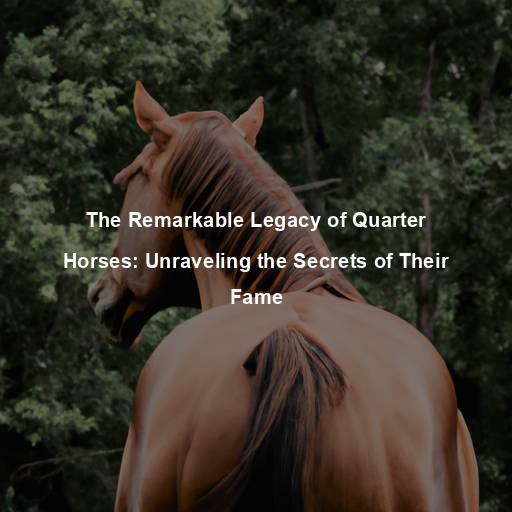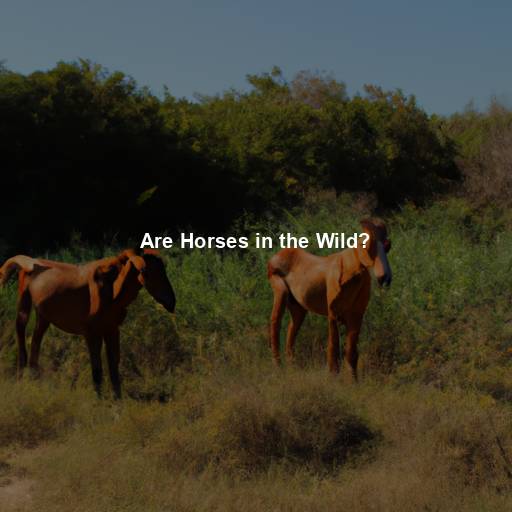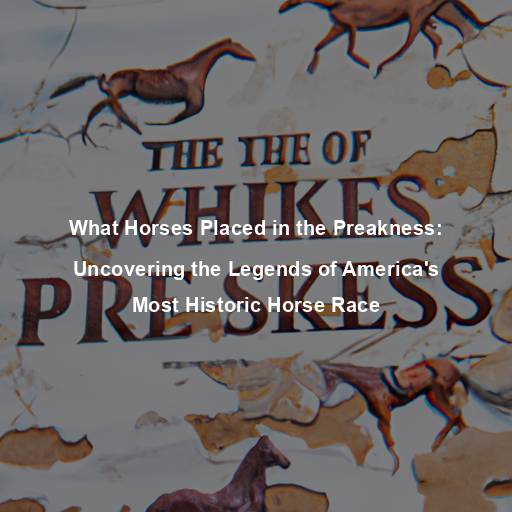Can Horses Live in the Wild?
Last Updated on August 4, 2023 by Evan
Contents [hide]
- 1 The Natural Habitat of Horses
- 2 The Evolutionary Adaptations of Horses
- 3 Human Intervention and the Domestication of Horses
- 4 Reintroduction of Horses into the Wild
- 5 The Importance of Balanced Conservation Efforts
- 6 Alternative Approaches to Wild Horse Conservation
- 7 The Ongoing Dialogue
- 8 Preserving the Spirit of the Wild
- 9 The Future of Wild Horses
- 10 The Enduring Spirit of Wild Horses
- 11 FAQs – Can Horses Live in the Wild?
- 11.1 Can horses survive in the wild without human intervention?
- 11.2 What do wild horses eat in their natural habitat?
- 11.3 How do wild horses find water sources in the wild?
- 11.4 How do wild horses protect themselves against predators?
- 11.5 Do wild horses need any additional care or medical assistance?
- 11.6 Why are some horses referred to as feral instead of wild?
- 11.7 Are there any conservation efforts to protect wild horse populations?
- 11.8 Can wild horses be domesticated after living in the wild?
The Natural Habitat of Horses
For centuries, humans have been awestruck by the sheer magnificence of horses. These noble creatures have wandered the wilds, their habitats spanning expansive grasslands, endless plains, and boundless open spaces. Known as mustangs, these untamed souls have carved out their existence in far-flung corners of the globe, from the vast North American expanses to the windswept lands of Europe and Australia. It is a testament to their astonishing adaptability and indomitable spirits that they not only endure but flourish amidst the unpredictability and challenges of the wild.
The Evolutionary Adaptations of Horses
Grazing and Foraging
Have you ever wondered what horses eat? Well, it turns out these majestic creatures are herbivores, meaning their diet mainly consists of grass and other plant materials. And let me tell you, their teeth and digestive systems have undergone some impressive evolution to maximize the extraction of nutrients from vegetation. In the wild, horses dedicate a considerable amount of time to grazing and foraging, ensuring they fulfill their nutritional requirements in the most natural way possible.
Strength and Speed
Horses stand out in the animal kingdom for their awe-inspiring combination of strength and speed, two indispensable qualities that play a vital role in their wild existence. These remarkable characteristics grant them the ability to swiftly elude formidable predators like wolves and cougars and embark on arduous journeys across vast stretches of land in pursuit of sustenance and hydration. Over time, their bodies have evolved with muscular frames, elongated limbs, and durable hooves, equipping them with the unparalleled power and agility needed to conquer and traverse diverse terrains with unfathomable finesse.
Social Structure
In the untamed realm of the wild, horses embody a captivating tapestry of dynamics. Roaming free in breathtaking herds, these majestic creatures ignite a melange of curiosity and bewilderment. At the helm of each herd stands a commanding stallion, surrounded by a constellation of mares and their brood. In their enigmatic language of calls, cues, and fragrant imprints, horses weave a intricate web of connection, fostering an intricate tapestry of social bonds within their kin.
Human Intervention and the Domestication of Horses
The Transition from Wild to Domesticated
While horses have a natural ability to live in the wild, their relationship with humans has significantly impacted their way of life. The domestication of horses dates back thousands of years when humans recognized their value as companions, modes of transportation, and sources of labor. Through selective breeding and taming, humans have shaped the characteristics and behaviors of horses, leading to the development of various breeds with distinct traits.
The Benefits and Challenges of Domestication
Throughout history, horses have forged an undeniable bond with humans, reaping the rewards of our unwavering care – from nourishing sustenance to cozy sanctuaries and essential medical assistance. Intricately woven into the tapestry of human societies, these majestic creatures play a multitude of roles, captivating us as devoted workers, mesmerizing showstoppers, and cherished companions. Nevertheless, this coexistence is far from hearts and roses, as it poses perplexing struggles for our equine companions. They rely on our intervention to satisfy their unique dietary and healthcare demands, all while their freedom remains somewhat confined in comparison to their untamed brethren.
Reintroduction of Horses into the Wild
The Concept of Re-Wilding
Over the past few years, there has been a surge of curiosity surrounding the idea of reintroducing domesticated horses back into the untamed wilderness. Referred to as re-wilding, this intriguing concept seeks to reestablish the delicate equilibrium of nature while simultaneously empowering these majestic creatures to embrace their untamed essence. By granting them the freedom to wander unfettered and reconnect with their instinctual roots, re-wilding endeavors to improve the overall welfare and happiness of these noble animals. It’s a captivating notion that both captivates and bewilders, leaving one to ponder the possibilities of a horse’s journey towards embracing its innate wildness.
Considerations and Challenges
Releasing domesticated horses back into the wild in an attempt to re-wild them might initially appear as a benevolent endeavor, but it is undoubtedly a complex undertaking. The acquired survival skills and innate instincts that their wild counterparts possess are often absent in domesticated horses, posing a perplexing challenge. Moreover, the genetic alterations and behavioral modifications resulting from human intervention may impede their seamless integration into existing wild horse communities. Therefore, thoughtful deliberation regarding appropriate habitats and potential clashes with native species is of utmost importance prior to embarking on such a venture.
The Importance of Balanced Conservation Efforts
Striking a Balance
The question of whether horses can live in the wild is not a simple one. It requires a delicate balance between preserving the natural habitats of wild horses and ensuring the well-being of domesticated horses. Conservation efforts should focus on protecting and restoring suitable habitats for wild horses, while also providing proper care and management for domesticated horses.
Responsible Ownership and Management
Ensuring the utmost care for our equine companions is no small feat. It demands a meticulous balance between responsible ownership and thoughtful management. From tail to hoof, a tapestry of nourishing nutrition, routine veterinary care, and ample exercise intertwines to cultivate their health, regardless of where they call home- be it the untamed wilderness or the cozy confines of our domesticity.
Genetic Considerations
Re-wilding horses presents a perplexing puzzle – the genetic aftermath of centuries of domestication. Selective breeding has accentuated certain traits, steering these equine beings away from their untamed ancestors. One can’t help but wonder how these genetic shifts might impact their survival instincts and adaptability in the wild. Will their ancestral toolkit still equip them with the necessary skills for self-preservation?
Social Integration
The integration of domesticated horses into established wild horse populations can present some intriguing social obstacles. The dynamics within wild horse herds are multifaceted, with intricate social structures and hierarchies already in place. Bringing in new individuals, particularly those unfamiliar with the intricacies of the wild, may upset the delicate balance of these relationships. This could potentially lead to conflicts and hurdles when attempting to assimilate into the existing herd, creating a perplexing situation that may impact the welfare of both the domesticated and wild horses involved.
Habitat Availability and Competition
The availability of suitable habitats for re-wilding horses is another critical factor to consider. The encroachment of human activities, such as agriculture and urbanization, has significantly reduced the natural habitats available for wild horses. Reintroducing domesticated horses into limited spaces may lead to increased competition for resources, such as food and water, potentially impacting the overall ecosystem balance and the well-being of other native species.
Alternative Approaches to Wild Horse Conservation
Sanctuaries and Reserves
Imagine a world where the spirit of wild horses runs free, untamed by the constraints of domestication. Rather than pushing these majestic creatures back into the wild, why not create safe havens where they can flourish and thrive? By establishing sanctuaries and reserves, we can offer a compromise, providing the space and freedom they need while ensuring their well-being and protecting the natural balance of our ecosystems. These dedicated areas, passionately monitored by trained staff, offer a glimmer of hope, where horses can roam in semi-wild bliss, engaging in their innate behaviors and forging social connections with their fellow equines.
Assisted Re-Wilding
Assisted re-wilding is another approach that combines elements of domestication and wild living. Horses in assisted re-wilding programs are given the opportunity to roam large areas of land, similar to wild horses, while still receiving some human care and oversight. This approach aims to strike a balance between the needs of horses and the challenges they may face in the wild, providing them with a more natural environment while ensuring their well-being and safety.
The Ongoing Dialogue
The idea of horses living in the wild has become a hot topic, engaging people from all walks of life – conservationists, horse lovers, and experts. There’s a constant back-and-forth communication, as our knowledge about wild horses’ behavior and their role in the ecosystem keeps expanding. With this ever-evolving understanding, we navigate the complex task of conserving and managing these majestic creatures. It’s important that we keep the lines of communication open, inviting diverse viewpoints, and carefully examining the advantages and obstacles that arise with each approach.
Preserving the Spirit of the Wild
The undeniable symbiotic connection between humans and horses has undeniably yielded countless benefits over time. However, amid this unyielding collaboration, it is of paramount importance to safeguard the untamed essence that defines these majestic creatures. Whether galloping freely through vast wildernesses or nestled beneath human guardianship, the core of equine existence calls for reverence and utmost respect. In our pursuit to protect these remarkable beings, endorsing a delicate equilibrium between their well-being and the safeguarding of their intrinsic behaviors and habitats becomes an intriguing challenge, paving the way for a perplexing journey into uncharted territories.
As we navigate the complexities of re-wilding and wild horse conservation, it is our responsibility to ensure that these magnificent creatures continue to inspire awe and admiration. By embracing sustainable management practices, promoting education, and fostering a deep appreciation for their place in the natural world, we can contribute to the well-being and preservation of horses for generations to come. ## The Role of Humans in Wild Horse Conservation
Research and Monitoring
The world of wild horse conservation goes far beyond the awe-inspiring act of re-wilding. It’s a web of perplexity where researchers and scientists dance hand-in-hand, unraveling the enigmatic behavior of these majestic creatures, deciphering the intricate dynamics of their populations, and discovering the hidden secrets of their habitat needs. By immersing ourselves in the realm of comprehensive research and diligent monitoring programs, we unveil valuable data that illuminates the path towards effective conservation strategies, empowering us to make informed decisions about the management of these untamed populations.
Habitat Restoration
Ensuring the survival of wild horses in the long run hinges on our commitment to preserving and reviving their natural habitats. By safeguarding the grasslands they depend on, providing reliable water sources, and reducing human interference, we can play a crucial role in restoring these majestic creatures’ homes. Joining forces with landowners, governments, and conservation organizations will pave the way for collaborative projects that build robust environments, allowing wild horse populations to flourish against all odds. Together, we can turn the tide and pave the way for a brighter future for these enigmatic creatures.
Education and Advocacy
It’s no secret that the preservation of our wild horses deserves our unwavering attention. To truly make a difference, however, we must embark on a multifaceted approach that leaves no stone unturned. By unveiling educational programs that bust myths and instill awareness, launching public outreach campaigns that ignite passion, and spearheading advocacy efforts that amplify our collective voice, we can take tangible steps towards ensuring a brighter future for these enchanting creatures. Together, let’s create a harmonious narrative that celebrates the inherent beauty and ecological significance of wild horses, and inspire a profound sense of responsibility within communities far and wide.
The Future of Wild Horses
Balancing Conservation and Management
The future of wild horses lies in finding a balance between conservation and management. As we strive to protect their natural habitats and preserve their wild nature, we must also address the challenges posed by increasing populations and limited resources. Implementing sustainable population control measures, such as fertility control programs, can help maintain balanced herd sizes and reduce the need for drastic interventions.
Collaboration and Partnerships
The dynamic world of wild horse conservation demands a synchronized symphony of collective efforts. Governments, passionate conservation organizations, visionary landowners, researchers with unyielding curiosity, and empathetic local communities must converge their diverse perspectives into a harmonious crescendo, crafting meticulous management plans that cater to the intricate demands of both free-spirited equines and their domesticated counterparts. Embracing the spirit of unity, fostering unwavering partnerships, and exchanging the invaluable currency of knowledge, we can forge an interconnected tapestry of unparalleled brilliance in our noble pursuit of wild horse preservation.
Embracing Innovative Solutions
Innovative solutions and technologies can play a significant role in addressing the challenges faced by wild horse conservation. Advances in fertility control methods, genetic research, and habitat management techniques offer promising avenues for sustainable management practices. Embracing these innovations can enhance our ability to preserve wild horse populations while ensuring their well-being and the ecological integrity of their habitats.
The Enduring Spirit of Wild Horses
The sheer magnificence of wild horses, with their untamed grace and indomitable spirit, has the power to captivate us all. As they traverse sprawling grasslands or coexist with humanity, their very existence ignites a profound sense of reverence and curiosity within us. Their preservation necessitates safeguarding their intrinsic customs, conserving their habitats, and advocating conscientious strategies to ensure the perpetuation of the wondrous tapestry of our pristine environment.
The realm of wild horse conservation is an intricate labyrinth, requiring utmost regard, compassion, and an unwavering dedication to enduring viability. By forging a collective path and embracing the weight of our joint stewardship, we fortify the profound connection future generations will foster with these awe-inspiring beings, majestic embodiments of unrestrained nature.
FAQs – Can Horses Live in the Wild?
Can horses survive in the wild without human intervention?
It’s truly remarkable how well horses can adapt to the wild, navigating their surroundings with a sense of purpose and self-reliance. These majestic creatures, commonly known as feral horses, possess an innate ability to seek out sustenance, locate sources of water, and create makeshift shelters. Additionally, their social nature shines through as they form tight-knit herds, fostering a strong sense of communal protection against potential predators. It’s astonishing to witness the burstiness of their instincts and the perplexity of their survival strategies in a world untouched by human intervention.
What do wild horses eat in their natural habitat?
In the untamed realm of the wild, horses roam freely, their diet an intricate dance of nature’s offerings. From the lush grasses that tickle their muzzles to the resilient shrubs that punctuate the landscape, these majestic creatures have a palate as diverse as their surroundings. With teeth designed to unlock the hidden riches of plant fibers, they gracefully partake in a finely orchestrated feast, unraveling the mysteries of nutrition in the most enchanting manner.
How do wild horses find water sources in the wild?
Is there anything more awe-inspiring than the wild horses and their extraordinary ability to navigate their vast natural habitat? These majestic creatures rely on their unparalleled senses to uncover precious water sources that sustain their untamed existence. Through a delicate dance of smell, sight, and sound, they effortlessly discern the subtlest hints of vegetation shifts and terrain variations that hint at the hidden oases of rivers, streams, and natural springs. It’s a perplexing talent that ensures the survival of these remarkable beings.
How do wild horses protect themselves against predators?
In the vast plains where untamed wilderness reigns, wild horses have mastered the delicate art of survival. These awe-inspiring creatures have birthed a symphony of bewildering strategies that baffle even the most astute observer. Unified in bands, these social enclaves embody the essence of strength in numbers, their collective instincts acting as an impenetrable shield against lurking predators. Adorned with a hierarchical order, where dominant males and females stand tall, they orchestrate a delicate dance of power and protection. Yet, nature has bestowed upon them a gift beyond compare – senses so finely tuned that they unveil the faintest whispers of danger. With ears pricked and eyes ablaze, their astonishing hearing and extraordinary eyesight weave a tapestry of perception, allowing for swift evasion should any shadow of peril darken their path.
Do wild horses need any additional care or medical assistance?
Wild horses are truly remarkable creatures that have evolved to thrive in their natural habitats without the need for constant human interference. Their resilience and adaptability enable them to navigate life’s challenges with remarkable self-sufficiency. While these majestic animals rarely require our assistance for their well-being, there are unique circumstances, like environmental disruptions or unforeseen calamities, where providing short-term aid in the form of food, water, or relocation becomes crucial to preserving their safety and continued existence.
Why are some horses referred to as feral instead of wild?
The term “feral” is often used to describe horses that are descendants of domesticated horses but currently live in the wild. These feral horses have either escaped or been intentionally released into the wild and have adapted to survive in their new environment. Although they possess some wild characteristics, their ancestry can be traced back to domesticated horses, which differentiates them from truly wild horse populations.
Are there any conservation efforts to protect wild horse populations?
Wild horses, those majestic creatures that roam free in our wilderness, are facing numerous challenges and threats to their very existence. However, worry not, for a multitude of conservation efforts are being steadfastly undertaken to safeguard their future. Collaboration between various organizations spanning government agencies, environmental groups, and passionate individuals is the driving force behind these initiatives. From implementing sustainable population control measures to shield their habitats from encroachment, these tireless efforts aim to educate and bring awareness to the importance of wild horse preservation.
Can wild horses be domesticated after living in the wild?
Wild horses, even those with feral characteristics, can be tamed and trained by humans through a process known as domestication. However, it is important to note that domestication does not occur overnight and requires time, patience, and expertise from experienced horse trainers. Wild horses have a strong instinct for self-preservation, so trust and respect must be established to form a bond with them and successfully transition them from a wild to domesticated lifestyle.







